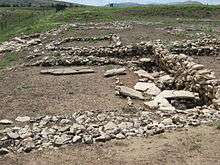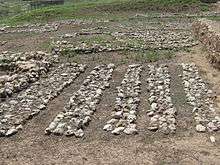Çayönü
 Çayönü | |
 Shown within Turkey | |
| Location | Diyarbakır Province, Turkey |
|---|---|
| Coordinates | 38°12′59″N 39°43′35″E / 38.21639°N 39.72639°ECoordinates: 38°12′59″N 39°43′35″E / 38.21639°N 39.72639°E |
| Type | Settlement |
| History | |
| Periods | Neolithic |
Çayönü is a Neolithic settlement in southeastern Turkey inhabited around 7200 to 6600 BC. It is located forty kilometres north-west of Diyarbakır, at the foot of the Taurus mountains. It lies near the Boğazçay, a tributary of the upper Tigris River and the Bestakot, an intermittent stream.
Archaeology


The first excavations were conducted by Robert John Braidwood between 1964 and 1978, and later between 1985 and 1991. The settlement covers the periods of the Pre-Pottery Neolithic A (PPNA), the Pre-Pottery Neolithic B (PPNB), and the Pottery Neolithic (PN).
The stratigraphy is divided into the following subphases according to the dominant architecture:
- round, PPNA
- grill, PPNA
- channeled, Early PPNB
- cobble paved, Middle PPNB
- cell, Late PPNB
- large room, final PPNB
Human sacrifice is indicated.[1]
Origin of Domestication
Animal Life - Domestication of Pigs and Cattle
Çayönü, Cafer Höyük, Nevalı Çori[2] is possibly the place where the pig (Sus scrofa) was first domesticated. The wild fauna include wild boar, wild sheep, wild goat and cervids. The Neolithic environment included marshes and swamps near the Boğazçay, open wood, patches of steppe and almond-pistachio forest-steppe to the south. It's also the site where the world's taurine cattle were domesticated from the aurochs.
Farming - Cultivation of Cereals
According to Der Spiegel[3] of either 6 March or 3 June 2006, the Max Planck Institute for Plant Breeding Research in Cologne[4] has discovered that the genetically common ancestor of 68 contemporary types of cereal still grows as a wild plant in the Vavilov zone on the slopes of Mount Karaca (Karaca Dağ), which is located in close vicinity to Çayönü. (Compare to information on cereal use in PPNA).
Robert Braidwood wrote that "insofar as unit HA can be considered as representing all of the major pre-historic occupation at Cayonu, cultivated emmer along with cultivated einkorn was present from the earliest sub-phase."[5]
See also
- Cities of the ancient Near East
- Göbekli Tepe
- Dja'de el-Mughara
Notes
- ↑ http://www.philipcoppens.com/gobekli.html - Göbekli Tepe: the world’s oldest temple
- ↑ "our data suggest a narrative that begins with the domestication of pigs in Southwest Asia, at Upper Tigris sites including Çayönü Tepesi (Ervynck et al. 2001) and possibly Upper Euphrates sites including Cafer Höyük (Helmer 2008) and Nevali Çori (Peters et al. 2005);
from google (Çayönü pig ancestor) result 2; 'Çayönü Tepesi' in wiki (Cattle)". - ↑ Der Spiegel
- ↑ Max Planck Institute for Plant Breeding Research
- ↑ Beginnings of Village-Farming Communities in Southeastern Turkey, 1972 by Braidwood et al, Proc. Natl. Acad. Sci. USA, Vol. 71, No. 2, pp. 568-572, February 1974
External links
| Wikimedia Commons has media related to Cayönü. |